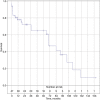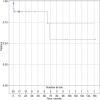Surgical portosystemic shunts in the era of TIPS and liver transplantation are still relevant
- PMID: 23961811
- PMCID: PMC4008167
- DOI: 10.1111/hpb.12163
Surgical portosystemic shunts in the era of TIPS and liver transplantation are still relevant
Abstract
Background: The surgical portosystemic shunts (PSS) are a time-proven modality for treating portal hypertension. Recently, in the era of liver transplantation and the transjugular intrahepatic portosystemic shunts (TIPS), use of the PSS has declined.
Objectives: This study was conducted to evaluate changes in practice, referral patterns, and short- and longterm outcomes of the use of the surgical PSS before and after the introduction of the Model for End-stage Liver Disease (MELD).
Methods: A retrospective analysis of 47 patients undergoing PSS between 1996 and 2011 in a single university hospital was conducted.
Results: Subgroups of patients with cirrhosis (53%), Budd-Chiari syndrome (13%), portal vein thrombosis (PVT) (26%), and other pathologies (9%) differed significantly with respect to shunt type, Child-Pugh class, MELD score and perioperative mortality. Perioperative mortality at 60 days was 15%. Five-year survival was 68% (median: 70 months); 5-year shunt patency was 97%. Survival was best in patients with PVT and worst in those with Budd-Chiari syndrome compared to other subgroups. Patency was better in the subgroups of patients with cirrhosis and other pathologies compared with the PVT subgroup. Substantial changes in referral patterns coincided with the adoption of the MELD in 2002, with decreases in the incidence of cirrhosis and variceal bleeding, and increases in non-cirrhotics and hypercoagulopathy.
Conclusions: Although the spectrum of diseases benefiting from surgical PSS has changed, surgical shunts continue to constitute an important addition to the surgical armamentarium. Selected subgroups with variceal bleeding in well-compensated cirrhosis and PVT benefit from the excellent longterm patency offered by the surgical PSS.
© 2013 International Hepato-Pancreato-Biliary Association.
Figures




Similar articles
-
Transjugular intrahepatic portosystemic shunt creation for cirrhotic portal hypertension is well tolerated among patients with portal vein thrombosis.Eur J Gastroenterol Hepatol. 2018 Jun;30(6):668-675. doi: 10.1097/MEG.0000000000001097. Eur J Gastroenterol Hepatol. 2018. PMID: 29462027
-
Effect of technical parameters on transjugular intrahepatic portosystemic shunts utilizing stent grafts.World J Gastroenterol. 2015 Jul 14;21(26):8110-7. doi: 10.3748/wjg.v21.i26.8110. World J Gastroenterol. 2015. PMID: 26185383 Free PMC article.
-
Outcomes of surgical shunts and transjugular intrahepatic portasystemic stent shunts for complicated portal hypertension.Br J Surg. 2017 Mar;104(4):443-451. doi: 10.1002/bjs.10431. Epub 2017 Jan 12. Br J Surg. 2017. PMID: 28079252
-
Transjugular intrahepatic portosystemic shunts and portal hypertension-related complications.World J Gastroenterol. 2014 Dec 7;20(45):16996-7010. doi: 10.3748/wjg.v20.i45.16996. World J Gastroenterol. 2014. PMID: 25493012 Free PMC article. Review.
-
Transjugular intrahepatic portosystemic shunts: an update.Liver Transpl. 2003 Mar;9(3):207-17. doi: 10.1053/jlts.2003.50045. Liver Transpl. 2003. PMID: 12619016 Review.
Cited by
-
Comparision between portosystemic shunts and endoscopic therapy for prevention of variceal re-bleeding: a systematic review and meta-analysis.Chin Med J (Engl). 2019 May 5;132(9):1087-1099. doi: 10.1097/CM9.0000000000000212. Chin Med J (Engl). 2019. PMID: 30913064 Free PMC article. Review.
-
One step minilaparotomy-assisted transmesenteric portal vein recanalization combined with transjugular intrahepatic portosystemic shunt placement: A novel surgical proposal in pediatrics.World J Gastroenterol. 2017 Apr 21;23(15):2811-2818. doi: 10.3748/wjg.v23.i15.2811. World J Gastroenterol. 2017. PMID: 28487619 Free PMC article.
-
Surgical portosystemic shunts versus devascularisation procedures for prevention of variceal rebleeding in people with hepatosplenic schistosomiasis.Cochrane Database Syst Rev. 2018 Aug 3;8(8):CD011717. doi: 10.1002/14651858.CD011717.pub2. Cochrane Database Syst Rev. 2018. PMID: 30073663 Free PMC article.
-
The Portosystemic Shunt for the Control of Variceal Bleeding in Cirrhotic Patients: Past and Present.Can J Gastroenterol Hepatol. 2022 Sep 17;2022:1382556. doi: 10.1155/2022/1382556. eCollection 2022. Can J Gastroenterol Hepatol. 2022. PMID: 36164663 Free PMC article. Review.
References
-
- Orloff MJ, Bell RH, Jr, Orloff MS, Hardison WG, Greenburg AG. Prospective randomized trial of emergency portacaval shunt and emergency medical therapy in unselected cirrhotic patients with bleeding varices. Hepatology. 1994;20(4 Pt 1):863–872. - PubMed
-
- Rikkers LF, Jin G, Burnett DA, Buchi KN, Cormier RA. Shunt surgery versus endoscopic sclerotherapy for variceal haemorrhage: late results of a randomized trial. Am J Surg. 1993;165:27–32. discussion 33. - PubMed
-
- Boyer TD, Haskal ZJ. The role of transjugular intrahepatic portosystemic shunt (TIPS) in the management of portal hypertension: update 2009. Hepatology. 2010;51:306. - PubMed
-
- Tripathi D, Helmy A, Macbeth K, Balata S, Lui HF, Stanley AJ, et al. Ten years' follow-up of 472 patients following transjugular intrahepatic portosystemic stent-shunt insertion at a single centre. Eur J Gastroenterol Hepatol. 2004;16:9–18. - PubMed
MeSH terms
LinkOut - more resources
Full Text Sources
Other Literature Sources
Medical

